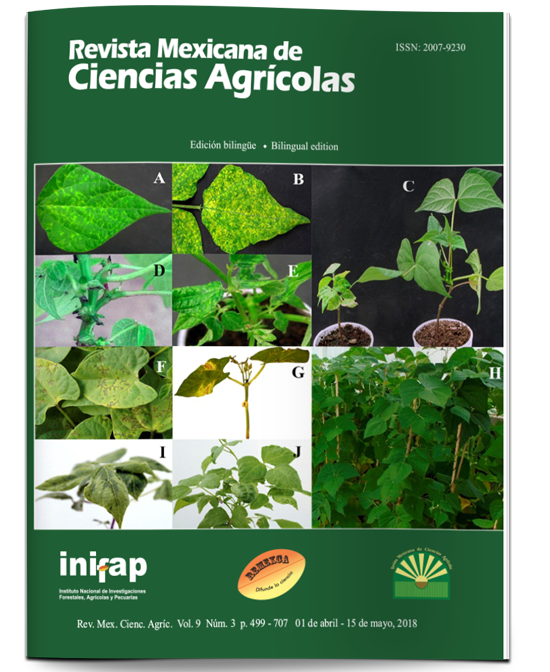Producción de sandía con portainjertos en suelos infestados con el virus de la mancha necrótica del melón
DOI:
https://doi.org/10.29312/remexca.v9i3.1217Palabras clave:
Olpidium bornovanus, injertos, MNSV, sandías silvestresResumen
México es uno de los principales productores de sandía a nivel mundial. Pero la presencia de patógenos del suelo como nematodos, Fusarium oxysporum f. sp. niveum y el virus de la mancha necrótica del melón (MNSV) representan un serio problema para los productores. El uso de plantas injertadas es una buena alternativa para hacer frente a estos problemas, ayudando a incrementar el rendimiento y calidad en sandía. Los portainjertos de sandía silvestre (Citrullus lanatus var. citroides) han demostrado ser eficaces para el control de la mayoría de las enfermedades que se transmiten a través del suelo, además de tener alta resistencia a nematodos; no obstante, no se tiene registro sobre su resistencia al MNSV. Se realizaron dos experimentos para evaluar la resistencia al MNSV de portainjertos para sandía. En el experimento 1 se evaluaron los portainjertos de híbridos interespecíficos “RS-841” “Ercole” (Cucurbita maxima×Cucurbita moschata) y de sandía silvestre los portainjertos “Robusta”, “RS0272” y “RS1833”. En el experimento 2 se evaluaron los portainjertos “RS-841”, “Ercole” y “Robusta”. En ambos casos en suelos infestados con MNSV. Los portainjertos de sandía silvestre fueron altamente susceptibles al MNSV, en cambio los híbridos interespecíficos mostraron resistencia a esta enfermedad. El portainjertos “RS-841” fue el que produjo los frutos de mejor calidad. El rendimiento fue inferior con diferencia significativa cuando se utilizaron los portainjertos de sandía silvestre.
Descargas
Descargas
Publicado
Cómo citar
Número
Sección
Licencia
Los autores(as) que publiquen en Revista Mexicana de Ciencias Agrícolas aceptan las siguientes condiciones:
De acuerdo con la legislación de derechos de autor, Revista Mexicana de Ciencias Agrícolas reconoce y respeta el derecho moral de los autores(as), así como la titularidad del derecho patrimonial, el cual será cedido a la revista para su difusión en acceso abierto.
Los autores(as) deben de pagar una cuota por recepción de artículos antes de pasar por dictamen editorial. En caso de que la colaboración sea aceptada, el autor debe de parar la traducción de su texto al inglés.
Todos los textos publicados por Revista Mexicana de Ciencias Agrícolas -sin excepción- se distribuyen amparados bajo la licencia Creative Commons 4.0 atribución-no comercial (CC BY-NC 4.0 internacional), que permite a terceros utilizar lo publicado siempre que mencionen la autoría del trabajo y a la primera publicación en esta revista.
Los autores/as pueden realizar otros acuerdos contractuales independientes y adicionales para la distribución no exclusiva de la versión del artículo publicado en Revista Mexicana de Ciencias Agrícolas (por ejemplo incluirlo en un repositorio institucional o darlo a conocer en otros medios en papel o electrónicos) siempre que indique clara y explícitamente que el trabajo se publicó por primera vez en Revista Mexicana de Ciencias Agrícolas.
Para todo lo anterior, los autores(as) deben remitir el formato de carta-cesión de la propiedad de los derechos de la primera publicación debidamente requisitado y firmado por los autores(as). Este formato debe ser remitido en archivo PDF al correo: revista_atm@yahoo.com.mx; revistaagricola@inifap.gob.mx.
Esta obra está bajo una licencia de Creative Commons Reconocimiento-No Comercial 4.0 Internacional.



